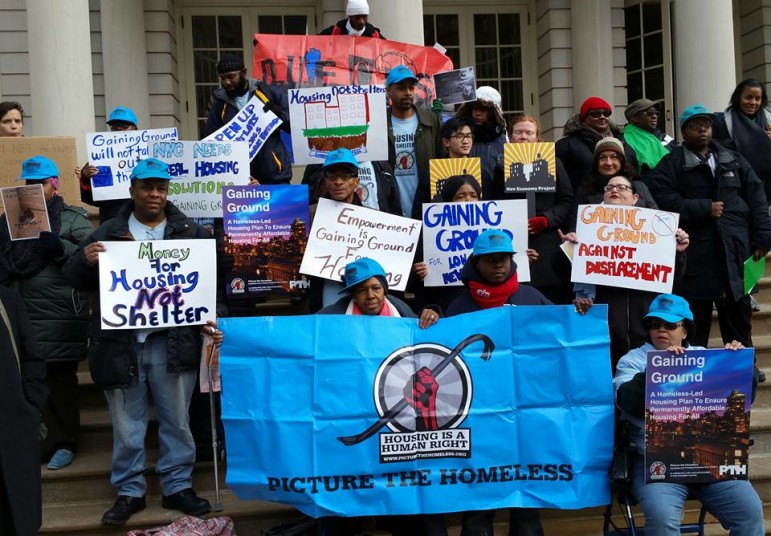
Sam Miller
Members of Picture the Homeless at a rally last month.
That’s it. Yeah.
Land is a man’s very own soul.”
You’ll have to forgive the gendered and corny quote from the 1992 Tom Cruise and Nicole Kidman un-classic “Far and Away,” but nobody waxes poetic about land like a dying father in a Hollywoodized version of the Irish immigration story.
The land problem facing Tom Cruise and his expiring “Da” was that someone else owned it all. The challenge that New York City has confronted in trying to address its housing crunch is that there simply isn’t enough of it. And the scarcity of land complicates efforts to build housing that serves the very lowest-income New Yorkers, because it means the city has to kick in larger subsidies to fill the gap between the land-debt the rent roll can support and how much the parcel cost. The more subsidies spent at each site, the fewer sites the city can build on within a specified budget. You get the math.
The mayor’s Zoning for Quality and Affordability proposal, one of two citywide zoning concepts that will receive City Council hearings next week, is one effort to reduce the land limitations, by increasing the height limits on certain buildings; the city can’t create new land but it can build upwards. The neighborhood-level rezonings in East New York, along Jerome Avenue and elsewhere have a similar purpose: Increasing density to get more out of land.
But one advocacy group has argued for years that the city is overstating its land shortage. Picture the Homeless says there are abandoned and vacant properties, belonging to the city and other parties, that could be developed into low-income housing—in particular, housing for the formerly homeless. The organization has been making that case since at least 2007, when it conducted a survey of vacant property in Manhattan in partnership with now-Comptroller Scott Stringer, them the borough president.
Skeptics have greeted PTH’s ideas about vacant and underused property with questions about methods and costs. Can the city force landowners to develop their property? Is it cost-effective to revamp derelict buildings when the money might go further in preserving already viable low-income housing?
PTH sought to answer some of those questions with a detailed policy plan released last week. It was written in partnership with Banana Kelly Community Improvement Association, CATCH Mutual Housing Association and Cooper Square Community Land Trust and Mutual Housing Association.
The reports rests not on a complaint that the de Blasio administration isn’t trying to address the homelessness crisis, but rather that the tools created so far aren’t strong enough. For instance, the administration’s LINC rental subsidies are time-limited, when permanent affordability is needed. And City Hall’s substantial commitment to supportive housing is laudable but that kind of housing doesn’t help people who are homeless because they are poor, not because of a substance-abuse or mental-health problem.
PTH and its partners propose a number of steps. Piggybacking on the mayor’s promise to end the Cluster Program, where homeless families are put up in private apartments at great expense, the group suggests that the city “utilize existing pathways to acquire these buildings in the public interest and transfer their ownership to responsible non-profit stewards, or to put the buildings under the receivership of a responsible non-profit administrator.” In other words, take the ownership or management of the buildings away from the current, for-profit landlord using the 7-A program, a lien sale, the Alternative Enforcement Program or even eminent domain.
The group also believes that there is enough vacant, city-owned land in New York to create housing that would accommodate half the existing shelter population, adding, “it is crucial that these properties be held for redevelopment as income-targeted housing, rather than sold or granted to market-rate developers.”
Finally, PTH focuses attention on struggling Tenant Interim Lease and Affordable Neighborhood Cooperative Program buildings. Both programs aim to help low-income tenants to buy their apartments, but many of the properties involved in those initiatives have a lot of vacancies and repair issues. PTH wants the city to fund repairs to bring those unused apartments online and create a community land trust that the properties would be sold into, so they can be preserved as affordable housing forever.
One homeless advocate, while generally supportive of PTH’s ideas, says the last proposal would involve steep costs because of the amount of work needed to bring buildings up to code.
Read the plan here:








